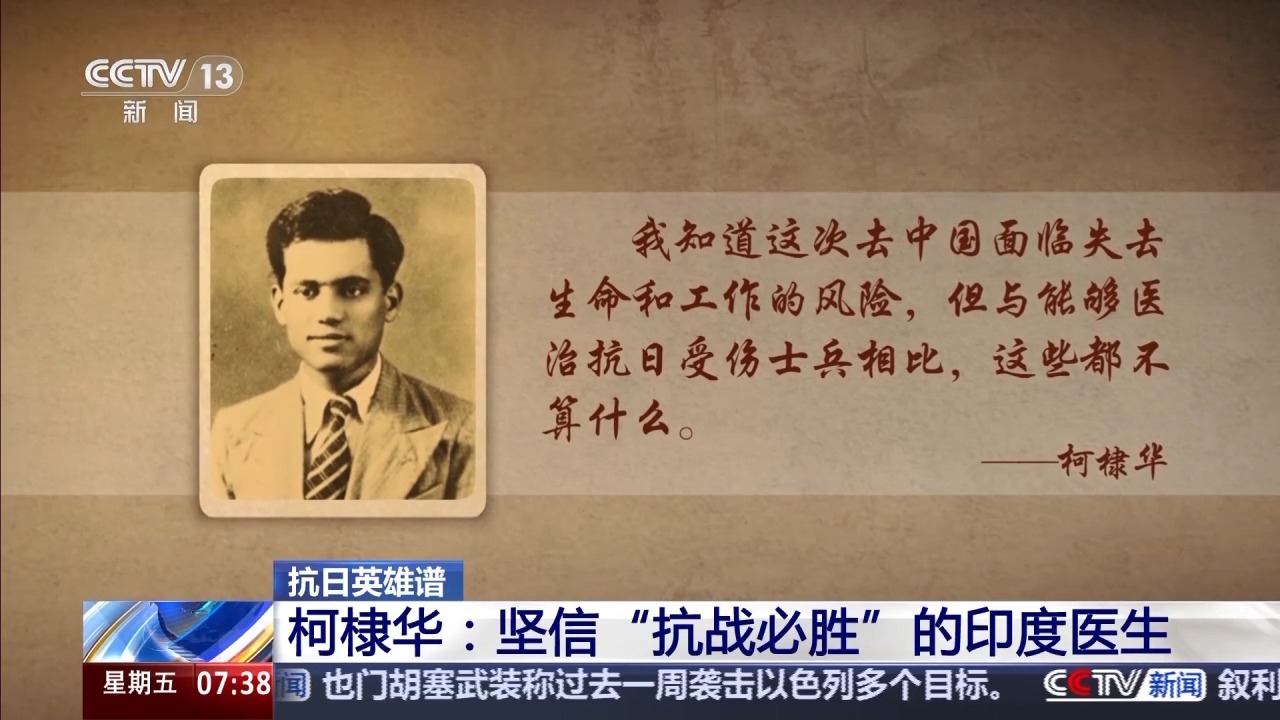During the War of Resistance Against Japan
A young Indian doctor, driven by idealism
Set foot on the war-torn land of China
And fought side by side with the Chinese people
Devoting his prime years and even his life
To the liberation cause of the Chinese nation
Meet the doctor hailed as “A Good Doctor Like Bethune”
A Symbol of Sino-Indian Friendship—Indian Doctor Dwarkanath Kotnis
“I know going to China risks my life and career, but compared to treating wounded soldiers of the resistance, these are nothing.” —Kotnis
This was written by Indian doctor Dwarkanath Kotnis in a letter to his family after his interview to join the medical aid team to China.
Kotnis, originally named Dwarkanath Shantaram Kotnis, was born in 1910 in Sholapur, Maharashtra, India. In 1936, he graduated from Grant Medical College, a prestigious medical school in India.
After the outbreak of the War of Resistance Against Japan, the Indian National Congress decided to send a small medical team to China. In 1938, the 28-year-old Kotnis resolutely joined the team and arrived in China that September.
To express their determination to aid China, all five members of the medical team adopted Chinese names with the character “Hua” (华). Kotnis became Ke Dihua.
Upon arriving in China, Kotnis witnessed the brutal atrocities of the Japanese army, which filled him with grief and anger. In February 1939, he reached Yan’an and later worked at the Eighth Route Army Hospital, where his exceptional medical skills quickly earned him trust and respect.
That autumn, Kotnis and his team proposed following in Norman Bethune’s footsteps to the frontlines. After over a month of arduous travel and breaking through blockades, they arrived at the Eighth Route Army headquarters in the Taihang Mountains of southeastern Shanxi.
In June 1940, Kotnis arrived at the Jin-Cha-Ji Military Command in Tang County, Hebei. Soon after, the second phase of the Hundred Regiments Offensive began. Kotnis volunteered for the frontlines, setting up a medical station as close to the battle as possible.
According to historical accounts, Kotnis led a medical team to the southern Fourth Military Division for battlefield rescue. In 13 days at the front, he treated over 800 wounded soldiers and performed surgeries on 585 of them—all while suffering from tapeworm disease.
Witnesses recalled that casualties kept pouring in from the frontlines, and Kotnis once worked for three days and nights without sleep. His internationalist spirit deeply moved Guo Qinglan, a nursing instructor at the Bethune School of the Jin-Cha-Ji Military District. In November 1941, they married.
Guo Qinglan later recalled how moved she was by Kotnis’s dedication despite the harsh conditions. “Both Bethune and Kotnis had this incredible ability to uplift spirits in the toughest environments,” she said.
Beyond saving lives on the battlefield, Kotnis also became the first director of the Bethune International Peace Hospital in 1941. Recognizing the urgent need for more medical personnel, he prioritized compiling medical textbooks—a challenging task for a foreigner. Every morning, Kotnis practiced writing Chinese characters for at least an hour or two.
Some of his handwritten manuscripts, annotated with Hindi and English for memorization, are preserved at the Kotnis Memorial Hall.
Kotnis’s younger sister Manorama once shared that his dark complexion earned him the nickname “Black Mother”—a term of endearment reflecting his nurturing care. Despite food shortages, Kotnis always insisted that patients be fed first before himself.
The Indian medical team was originally scheduled to stay only six months to a year. But when faced with the choice, Kotnis firmly decided to remain in China. In July 1942, he joined the Communist Party of China under the party flag.
That summer, Kotnis suffered epileptic seizures. Despite poor medical conditions in the base area and urging from Nie Rongzhen to seek treatment in Yan





